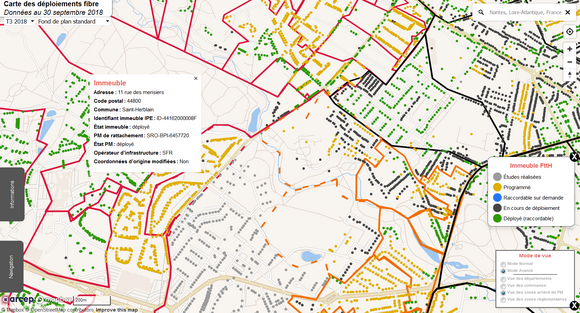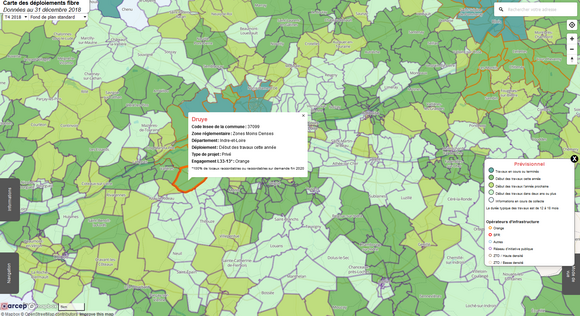Today, Arcep is publishing its scoreboard for the fixed broadband and superfast broadband market (rollouts and subscriptions) in France as of the end of September 2019. This quarter confirms the ongoing progress in FttH subscription numbers and rollouts.
SUBSCRIPTIONS: the number of superfast access lines has reached 10.6 million. This increase is due almost entirely to the rise in end-to-end fibre optic line numbers.
- Over the course of Q3 2019, the number of superfast broadband subscriptions (maximum download speed equal to or faster than 30 Mbit/s) increased by 550,000 to reach 10.6 million. This means an additional 2.3 million subscriptions year on year (YoY), versus an increase of 1.9 million one year earlier. Thirty six percent of all subscribers in France now have a superfast access line.
- Virtually all of this growth is due to an increase in the number of subscriptions to fibre to the home/building (FttH/B) plans, which rose by 540,000 compared to the previous quarter and so accounting for close to 98% of the increase in superfast access user numbers. As of 30 September 2019, the number of end-to-end fibre access lines totalled 6.4 million, which marks an increase of more than 2 million in a single year.
- In total, 47% of all premises eligible to subscribe to a superfast access plan were subscribing to such a plan in Q3 2019, which marks a 4% increase YoY.
- The total number of broadband and superfast broadband subscriptions stood at 29.5 million at the end of Q3 2019, which is 170,000 more than in the previous quarter and of 630,000 more than the year before (+2.2% YoY).
ROLLOUTS: as in the previous quarter, the pace of deployments is increasing, but must continue to accelerate
Over the past four quarters, 4.2 million additional premises have been passed for FttH, of which 1.16 million in in Q3 2019 – which means a roughly 60% increase year on year. This quarter now comes to replace the previous one for breaking all quarterly growth records.
- As of 30 September 2019, 16.7 million premises were eligible to subscribe to an FttH access service, or 34% more than one year earlier.
- The majority of the growth continues to be in those parts of the country where the Government has issued a call for investment letters of intent (called "zones AMII" in French): more than 700,000 additional premises were rendered eligible during this past quarter.
- The pace of FttH rollouts in areas covered by public-initiative rollouts rose once again during the quarter, with an additional 350,000 additional premises passed in Q3 2019. The overall rate of line sharing rose significantly, overstepping the 50% mark for the first time. It nevertheless continues to be far below the rate in areas covered by public-initiative rollouts where it stands at over 90%.
- In total, at the end of Q3 2019, 22.4 million households in France were able to subscribe to a superfast internet access service, all technologies combined, including 16.1 million households located outside of very high-density areas.
- FttH rollout data have been updated on the cartefibre.arcep.fr website and in the Open Data made available by Arcep.
Monitoring the legally binding FttH rollout commitments that operators have made in “zones AMII”
Arcep is responsible for monitoring operators Orange and SFR’s compliance with the obligations they have made.
At the end of Q3 2019, around 60% of the premises in the municipalities where Orange made rollout commitments, and 56% of those where SFR has made commitments have been passed for fibre. Operators will need to step up the pace of their deployments if they are to meet their targets on time.
To be able to monitor operators’ rollouts, Arcep needs to evaluate the number of premises in each municipality that need to be connected. To do so, up until now it has made its calculation (an approximation in the mathematical sense of the word) based on figures produced by France’s National Institute of Statistics and Economic Studies, INSEE[1].
The progress that operators have made in their field studies has opened up the possibility of using a new frame of reference, namely operators’ enhanced prior information, or “IPE”, files which are designed specifically for marketing the deployed networks, and to obtain a more relevant estimate of the number of premises that need to be made eligible.
Arcep has thus begun to work on incorporating this new frame of reference, and on updating the number of premises that still need to be passed – which is the target figure for operators’ commitments.
Tracking FttH rollouts
The cartefibre.arcep.fr website allows users to obtain fibre coverage information on individual buildings, and so to track the progress of FttH rollouts in a very detailed fashion. The forecast view also provides them with information on the timeline for upcoming optical fibre rollouts in a given municipality.
This information associated with these rollout maps, both existing and forecast, are available as open data.
[1] For each municipality, Arcep adds together Insee 2014 housing figures and an estimate of the number of premises being used by businesses, based on establishments that reported a positive number of employees (Insee 2015 figures).
Associated documents
• Fixed broadband and superfast broadband services scorecard – figures for Q3 2019
• FttH rollout monitoring maps: https://cartefibre.arcep.fr/
• Data available as open data


